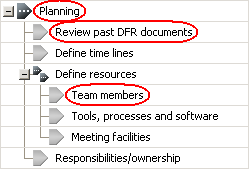

 |
Related Topics: | |
Certain properties of gates in the DFR planner can be directly edited, and the remaining properties are automatically determined from those. This topic provides a brief overview of the logic that the software uses to determine a gate's properties.
The DFR planner uses the following logic to determine the start, due and completion dates of higher-level gates based on their lower-level gates/actions.
If a gate is without a precedent (i.e., without a prior gate on the same level), then its default start date can be changed directly. For example, in the image below, only the gates outlined in red can have their start dates changed directly.

If a gate does have a precedent, its start date is equal to the precedent gate's due date.
The due date and duration can be changed directly for any gate.
When you change the due date, the software will automatically change the duration by calculating the difference between the start date and the new due date.
When you change the duration, the software will automatically change the due date by adding the duration to the start date.
If all of a gate's dependents have a completion date, then its completion date is equal to the latest completion date of those dependents. If any dependent is missing a completion date, then the higher-level gate has no completion date.
The software uses the following logic to determine the status of gates and actions based on their start dates, due dates and completion dates. The status is indicated by an icon in the Status column: ![]() = Not Started,
= Not Started, ![]() = In Progress,
= In Progress, ![]() = Complete and
= Complete and ![]() = Overdue.
= Overdue.
A gate/action is Not Started if its start date is later than today's date.
It is In Progress if (a) its start date is today's date or earlier and (b) its due date is today's date or later.
It is Complete if any completion date has been entered (even if the completion is later than today's date).
It is Overdue if its due date is prior to today’s date.
© 1992-2013. ReliaSoft Corporation. ALL RIGHTS RESERVED.